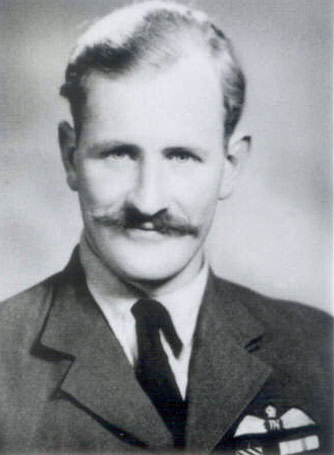Spitfire K9997
History:
FF 1-6-39 504Sq 2-11-39 603Sq 6-11-39 Failed to ensure u/c fully locked Prestwick CA 22-12-39 P/O BG Stapleton safe AST 6-1-40 CB 17-4-40 609Sq 4-6-40 Damaged enemy action 12-8-40 7OTU 5-10-40 57OTU Bounced and stalled landing tyre burst and u/c collapsed Speke CB 17-4-41 Sgt RW Jenkins safe SAL 22-4-41 53OTU 17-7-41 u/c collapsed taxying Llandow CB 22-8-41 Sgt DG Weekley safe. ros 26-8-41 u/c collapsed landing Llandow AC 5-10-41 Sgt EA Southey safe. Swung on landing tipped on nose and hit X4819 Llandow CE 24-1-42 Sgt WJ Basey (RAAF) safe* for acronyms please see source: Spitfire Production
add
Links (URLs):
Pilots:
| Name | Date | Rank | Status |
|---|---|---|---|
| none yet linked |
note: 'pilot to aircraft' linkage created via Pilot's page
post
Comments / Questions:
by: Red Dragon Fg Off Basil Gerald Stapleton 2017-04-28 17:14:41
Basil Gerald Stapleton was born in Durban, South Africa on 12th May 1920. He was educated at Edward VI School, Totnes, Devon. He joined the RAF on a short service commission and began his initial training on 23rd January 1939 at 13 E&RFTS White Waltham.
He moved on to 13 FTS Drem for No. 1 Course, which ran from 15th April to 21st October. With his training completed, Stapleton joined a detachment of 219 Squadron at Redhill on 21st October. The attachment ceased and he went to 11 Group Pool St. Athan on the 23rd.
After converting to Hurricanes, Stapleton joined 32 Squadron at Biggin Hill on 20th November 1939 and then joined 603 Squadron at Prestwick on 16th December. He converted to Spitfires on the squadron. On the 22nd, after landing at Prestwick on soft ground he tipped Spitfire K9997 on to its nose.
It was while he was serving with 603 Squadron that Stapleton got his nickname 'Stapme'. This was the phrase called out when the cartoon hero 'Just Jake' pursued an attractive girl. Stapleton would pin the daily cartoon strip on the squadron notice board.
On 14th January 1940 Stapleton joined the 603 Squadron detachment at Montrose, tasked with convoy patrols. On 26th April he baled out of his Spitfire at night after his undercarriage had been damaged attempting a night-landing.
On 5th June Stapleton made a crash-landing at Turnhouse on his fourth attempt to land after his flaps and then brakes failed, in Spitfire N3236.
On 3rd July 1940 Stapleton shared in the destruction of a Ju88, on the 20th he shared a Do17, on 29th August he probably destroyed a Me109 and damaged another and on the 31st he probably destroyed another.
On 5th September he shot down a Me109, which made a forced-landing at Loves Farm, Winchet Hill, Marden. The pilot, Oblt. Franz von Werra of Stab II/JG3, became known as 'the one that got away' after he escaped from imprisonment in Canada and made his way back to Germany. A book and film of the same title were made. In this engagement Stapleton probably destroyed another Me109.
On the 7th Stapleton made a forced-landing at Sutton Valence after a combat with enemy fighters over South London in Spitfire N3196, unhurt.
On 11th September he probably destroyed a Me110 and damaged a Me109, on the 15th destroyed a Do17 and damaged another Me109, on the 17th he got a probable Me109, on the 30th and 15th October he destroyed two more, on the 17th and 20th he probably destroyed another two Me109's and he had his final victory on 11th November, another Me109.
Stapleton was awarded the DFC (gazetted 15th November 1940).
Tour-expired, Stapleton was posted to No. 4 Aircraft Delivery Flight on 27th March 1941. He commanded 611 Squadron at Rochford from 18th May to 21st June, when he was posted away to join the Merchant Ship Fighter Unit.
He completed four North Atlantic convoy trips without being launched.
On 14th January 1942 Stapleton was posted to 257 Squadron at Honiley as a Flight Commander. At the end of his second tour he went to 2 ADU on 6th April 1943, remaining with it until 1st September when he was posted to Kenley as Sector Gunnery Instructor.
On 25th July 1944 he joined 83 GSU and on 26th August he was given command of 247 Squadron in France.
On 17th September the squadron operated in support of the airborne operations at Nijmegen and Arnhem. Stapleton led the initial attack by eight Typhoons against German gun positions threatening the British Second Army's advance along the road to Eindhoven.
Over the next two days Stapleton led more formations against the enemy, but bad weather forced some sorties to be aborted. The squadron then moved to Eindhoven, where the Typhoons landed between the bomb craters.
On 23rd December 1944 Stapleton was strafing a train when the locomotive exploded. Pieces of debris punctured the radiator of his Typhoon. He headed for the Allied lines but had to make a forced-landing before reaching them. He was made a PoW and spent the final months of the war in Stalag Luft 1 at Earth.
Stapleton was freed, returned to England and was released from the RAF on 31st January 1946 as a Squadron Leader. He was awarded the DFC (Dutch) (gazetted 1st January 1946).
Stapleton joined BOAC, flying West African routes for three years before returning to South Africa. There he spent six years as a technical representative with Dunlop, then seven years as works engineer with Sprite Caravans. Whilst living in Botswana he escorted tourists on photographic safaris in southern Africa before returning to Britain in 1994.
He was a great supporter of Battle of Britain commemorative events where his flamboyant ties, large floppy hat and luxuriant moustache attracted much interest.
Basil Gerald Stapleton died on 13th April 2010.
Ref:-THE BATTLE OF BRITAIN LONDON MONUMENT
reply

